Time:2025-06-24
In the ever - evolving realm of lighting technology, high - density RGB silicone neon strip designs have emerged as a revolutionary force. These innovative lighting solutions combine the flexibility and durability of silicone with the vibrant, customizable nature of RGB lighting, all while packing a higher density of LEDs. This results in enhanced illumination, more precise color control, and a broader range of applications. This article delves into the intricacies of high - density RGB silicone neon strip designs, exploring their technology, advantages, applications, and the factors to consider when choosing them.
The Technology Underlying High - Density RGB Silicone Neon Strips
RGB Lighting Technology
At the core of these neon strips is the RGB (Red, Green, Blue) lighting technology. Each LED within the strip contains three distinct light - emitting diodes for red, green, and blue. By precisely regulating the electrical current flowing through each of these LEDs, an extensive and virtually limitless spectrum of colors can be generated. This technology empowers lighting designers and enthusiasts to create a diverse array of lighting effects, from soft, warm glows to bright, vivid colors. Whether it's setting a cozy ambiance in a living room or crafting a high - energy atmosphere for a club, the RGB technology in these strips offers the versatility to bring any lighting vision to fruition.
High - Density LED Placement
The high - density aspect of these neon strips is characterized by a greater number of LEDs packed into a given length. This increased density leads to several advantages. Firstly, it results in more intense and uniform illumination. With more LEDs, the light output is stronger, and the distribution of light along the strip is more even, reducing the appearance of hotspots or dim areas. Secondly, high - density LED placement allows for more precise color mixing. Since there are more individual color - producing elements (the red, green, and blue LEDs), the combination of these colors can be more accurately controlled, leading to a wider range of achievable colors and more seamless color transitions.
Silicone Encapsulation
The silicone casing that encloses the LEDs and the internal circuitry of these neon strips serves multiple crucial functions. Silicone is a highly flexible material, enabling the strips to be easily bent, shaped, and installed on various surfaces. This flexibility makes them ideal for applications where a custom fit is required, such as wrapping around curved furniture, outlining irregular - shaped objects, or creating unique lighting installations.
In addition to its flexibility, silicone offers excellent durability. It is resistant to moisture, dust, and physical damage, making these strips suitable for both indoor and outdoor use. The silicone also helps to protect the LEDs from environmental factors that could potentially shorten their lifespan, such as exposure to UV rays. This makes high - density RGB silicone neon strips a reliable choice for long - term lighting projects.
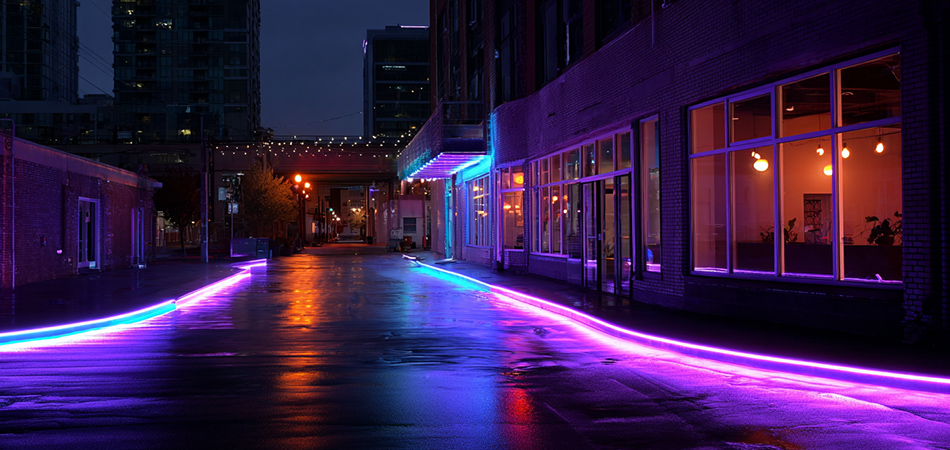
Advantages of High - Density RGB Silicone Neon Strip Designs
Enhanced Brightness and Illumination
The higher density of LEDs in these strips directly translates to enhanced brightness. Whether used for general lighting, accent lighting, or creating special effects, the increased light output can make a significant impact. In large - scale commercial spaces, such as shopping malls or exhibition halls, the bright illumination from high - density neon strips can effectively draw attention to products or displays. In outdoor applications, like illuminating building facades or pathways, the strong light output can cut through ambient light and create a visually striking effect.
Precise Color Control and Vivid Color Rendering
With more LEDs, the color - mixing capabilities of these strips are greatly enhanced. This allows for more precise control over the final color output. Lighting designers can achieve more accurate and vivid color renditions, which is crucial for applications where color accuracy matters, such as in art galleries, theaters, or fashion shows. The ability to create a wide range of colors with high precision also means that the strips can be used to match specific color schemes or branding requirements.
Flexibility in Installation and Design
The flexible nature of the silicone casing, combined with the high - density LED design, provides unparalleled flexibility in installation and design. The strips can be bent into tight curves or wrapped around complex shapes without compromising the performance of the LEDs. This makes them suitable for a variety of installation scenarios, from installing them along the edges of staircases to creating intricate lighting patterns on ceilings or walls. The flexibility also allows for easy integration into existing decor or architectural features.
Durability and Longevity
The silicone encapsulation, along with the high - quality components used in high - density RGB silicone neon strips, contributes to their durability and longevity. The strips can withstand harsh environmental conditions, including moisture, heat, and cold. The resistance to physical damage means that they can be used in areas where they may be accidentally bumped or touched. This durability not only reduces the need for frequent replacements but also ensures that the lighting installation maintains its performance over time.
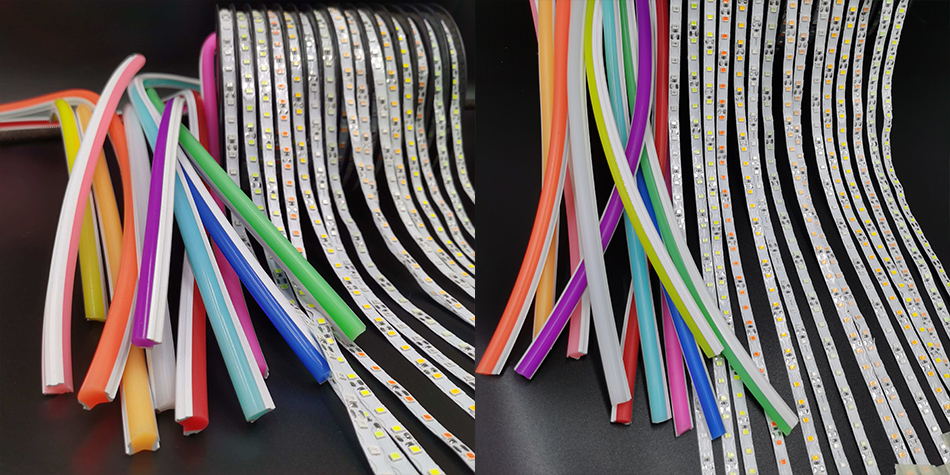
Applications of High - Density RGB Silicone Neon Strips
Residential Interior Decor
In homes, high - density RGB silicone neon strips are used to enhance the aesthetic appeal of various rooms. In the living room, they can be installed behind the TV, along the edges of shelves, or under the sofa to create a cozy and modern ambiance. The enhanced brightness and precise color control allow homeowners to set the mood according to their preferences, whether it's a warm, relaxing glow for movie nights or a bright, energetic light for entertaining guests.
In bedrooms, the strips can be used to create a soothing or romantic atmosphere. They can be placed around the headboard, under the bed, or along the edges of the windows. The flexibility of the strips enables them to be installed in a way that complements the room's decor, adding a touch of elegance and style.
Commercial Spaces
For commercial establishments, high - density RGB silicone neon strips are a powerful marketing and branding tool. In retail stores, they can be used to create eye - catching window displays that draw customers' attention. The ability to control the color and lighting effects allows for the creation of dynamic and engaging displays that can be changed according to the season, promotions, or product launches.
In restaurants and cafes, the strips can be used to set the mood. Different lighting scenes can be created for different times of the day or special events. For example, a warm, inviting light can be used during the day, while a more colorful and energetic lighting scheme can be implemented in the evening for a livelier atmosphere.
Event Spaces
At parties, weddings, and other special events, high - density RGB silicone neon strips are used to create a lively and inviting atmosphere. They can be installed around the perimeter of the event space, on stage backdrops, or to highlight specific areas such as the dance floor or the buffet table. The enhanced brightness and vivid color rendering can make the event more visually appealing and memorable for guests. The ability to synchronize the lighting with music or other event elements adds an extra layer of entertainment value.
Architectural and Landscape Lighting
Architects and landscape designers use high - density RGB silicone neon strips to enhance the visual appeal of buildings and outdoor spaces. In architecture, the strips can be used to accentuate the unique features of a building's facade, such as columns, arches, or eaves. They can also be installed along walkways, steps, and railings for both functional and aesthetic lighting.
In landscape lighting, the strips can be used to illuminate trees, shrubs, and flower beds, creating a beautiful and inviting outdoor environment. The flexibility of the strips allows them to be installed in a way that complements the natural features of the landscape, adding a touch of magic to the outdoor space.
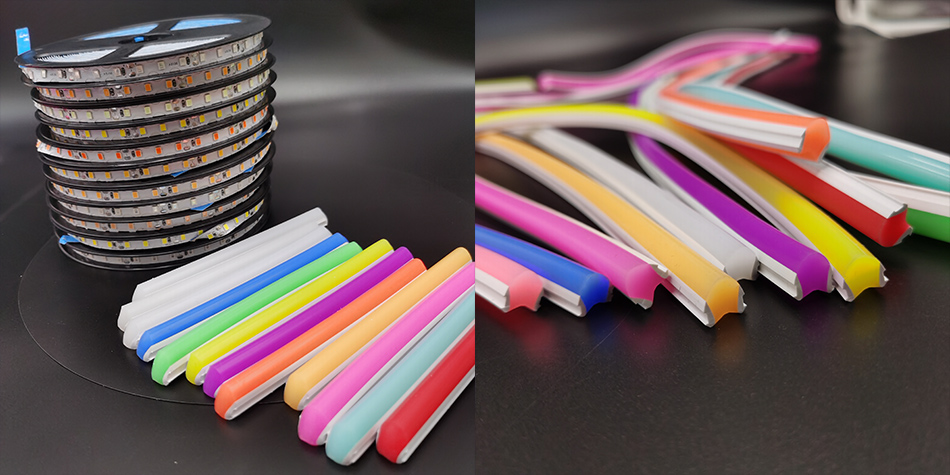
Factors to Consider When Choosing High - Density RGB Silicone Neon Strips
Color Quality and Range
When choosing high - density RGB silicone neon strips, it's essential to consider the color quality and range they offer. Look for strips that provide a wide spectrum of vivid and accurate colors. The color rendering index (CRI) is an important factor to consider, as a higher CRI indicates that the colors produced by the strip will be more true to life. Additionally, check if the strip allows for smooth color transitions and if it can create the specific lighting effects you desire, such as fading, flashing, or strobing.
Density and Light Output
The density of the LEDs and the resulting light output are crucial considerations. Determine the level of brightness required for your application. If you need to illuminate a large area or create a strong visual impact, choose strips with a higher density of LEDs and a greater light output. However, if you're aiming for a more subtle lighting effect, a lower - density strip may be sufficient. Consider the distance from which the strip will be viewed and the overall lighting requirements of the space.
Flexibility and Bend Radius
The flexibility of the strip and its minimum bend radius are important factors, especially if you plan to use it for complex shapes or tight curves. Strips with greater flexibility will be easier to work with and can be bent into more intricate shapes without damaging the internal components. Check the product specifications for the minimum bend radius of the strip. If you need to wrap the strip around small - diameter objects or create sharp curves, choose a strip with a low minimum bend radius to ensure a smooth and seamless installation.
Power Requirements
Understand the power requirements of the neon strips. Different strips may require different voltages and currents. Make sure that you have a power source that can supply the necessary power to the strip, especially if you are using a long length or multiple segments. Some strips may come with a power adapter, while others may require you to purchase one separately. Consider the energy efficiency of the strip in relation to its power consumption to ensure that it fits your energy - saving goals.
Brand Reputation and Quality
Choose high - density RGB silicone neon strips from a reputable brand with a track record of producing high - quality lighting products. Read customer reviews and testimonials to get an idea of the product's performance, durability, and reliability. A well - known brand is more likely to use high - quality materials and manufacturing processes, which can result in a longer - lasting and more reliable product. Additionally, consider the warranty offered by the manufacturer. A longer warranty period indicates the manufacturer's confidence in the product's quality and provides you with some peace of mind in case of any issues.
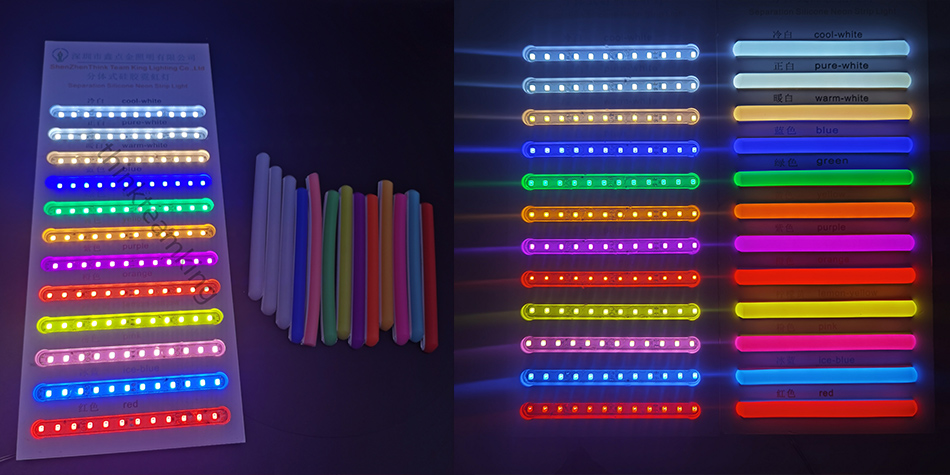
Installation and Setup of High - Density RGB Silicone Neon Strips
Pre - installation Preparation
Before installing the neon strips, carefully plan the layout of the lighting. Determine where you want to install the strips, taking into account the space's design, the movement of people, and the overall lighting concept. Measure the areas where the strips will be installed to ensure that you have the correct length of strips. Clean the surfaces where the strips will be attached to remove any dust, dirt, or grease. This will help the adhesive backing (if applicable) to stick properly or ensure a secure attachment with mounting hardware.
If you are using a control system, familiarize yourself with its operation and ensure that it is properly configured. Test the control system with a sample strip (if possible) to make sure that it can accurately control the color, brightness, and lighting effects of the strips.
Installing the Neon Strips
If the strips have adhesive backing, peel off the protective layer from the back of the strip and carefully press it onto the prepared surface. Start from one end and work your way along, making sure the strip is straight and firmly attached. If you need to bend the strip, do so gently, following the recommended minimum bend radius. For more secure installations or for surfaces where adhesive may not be sufficient, use the provided mounting hardware, such as clips or screws, to attach the strips.
When connecting multiple strips together, follow the manufacturer's instructions carefully. Some strips may require special connectors or splicing techniques to ensure a proper electrical connection. Make sure that all connections are secure and protected from moisture, especially if the strips are being used in a wet or humid environment.
Connecting to the Power Source and Control System
Connect the neon strips to the appropriate power source. Ensure that the power supply is capable of providing the correct voltage and current for the strips. Use the correct cables and connectors to make the electrical connections, and follow safety guidelines to prevent electrical hazards.
Once the strips are powered, connect them to the control system. This may involve connecting the strips to a DMX controller, a wireless control device, or a computer - based lighting control software. Follow the setup instructions for the control system to configure the settings for the neon strips, such as the color, brightness, and lighting effects. Test the system to make sure that the strips are responding correctly to the control signals.
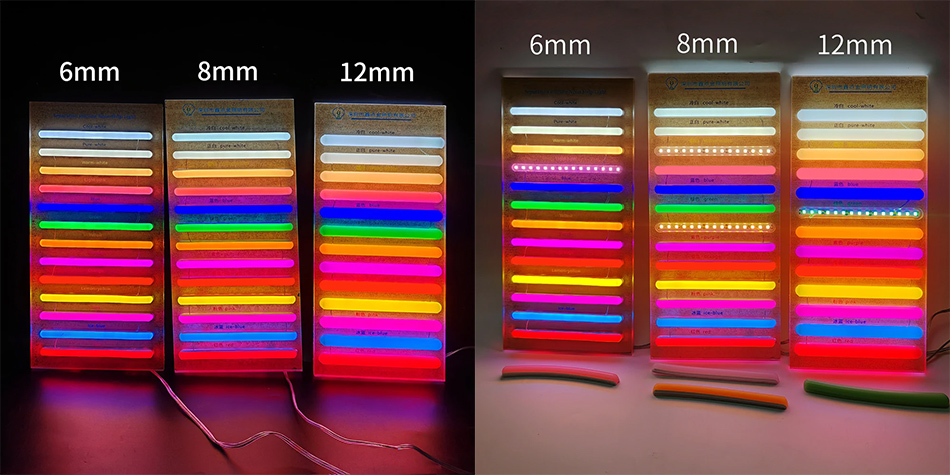
Maintenance and Troubleshooting of High - Density RGB Silicone Neon Strips
Regular Maintenance
Regular maintenance of the neon strips is relatively simple. Periodically check the strips for any signs of damage, such as cracks in the silicone casing, loose connections, or discoloration. If you notice any damage, address it immediately to prevent further issues. Clean the strips gently with a soft, damp cloth to remove any dust, dirt, or debris that may have accumulated over time. This will help to keep the light output bright and even.
If the strips are used outdoors, pay special attention to any signs of wear and tear caused by exposure to the elements. Check for any signs of UV damage, such as fading or cracking of the silicone. Inspect the electrical connections for any signs of corrosion or moisture ingress.
Troubleshooting Common Issues
If the strips are not lighting up, first check the power connection to make sure that the power source is working and the connections are secure. Check the fuse or circuit breaker in case of a power outage. If the color of the strips is incorrect or inconsistent, check the settings on the control system. Make sure that the correct color values are being sent to the strips.
If the lighting effects are not working as expected, review the programming of the control system. Check for any errors in the lighting sequence or settings. In some cases, a software update for the control system may be required to fix any bugs or improve performance. If the strips are experiencing flickering or dimming, it could be due to a power issue, a problem with the control system, or a faulty strip. Try isolating the problem by testing individual strips or sections of the lighting setup.
Future Trends and Innovations in High - Density RGB Silicone Neon Strip Designs
Integration with Smart Home and Building Systems
The future of high - density RGB silicone neon strips lies in greater integration with smart home and building systems. As technology continues to advance, these strips will be able to communicate with other smart devices, such as sensors, actuators, and other lighting fixtures, to create more complex and dynamic lighting scenes. For example, motion sensors could be used to trigger changes in the lighting effects of the neon strips based on the movement of people in a room. Temperature and humidity sensors could also be integrated to adjust the lighting based on the environmental conditions.
Smart home and building systems may also allow for remote control and monitoring of the neon strips. Lighting designers and homeowners could control the strips from a mobile device or a computer, even when they are not on - site. This would provide greater flexibility and convenience, especially for large - scale properties or commercial buildings.
Advancements in LED and Silicone Technologies
Ongoing research and development in LED and silicone technologies will lead to even more advanced neon strips. We can expect to see LEDs with higher brightness, better color accuracy, and lower power consumption. New silicone materials may be developed that offer even greater flexibility, durability, and waterproofing capabilities. These advancements will not only improve the performance of the neon strips but also open up new possibilities for lighting design.
For example, LEDs with enhanced color - mixing capabilities may allow for the creation of even more unique and precise color combinations. Silicone materials that are more resistant to extreme temperatures or chemical exposure may make the strips suitable for even more challenging environments.
Expansion into New Markets and Applications
As high - density RGB silicone neon strip designs continue to evolve, they are likely to expand into new markets and applications. In addition to the residential, commercial, and event sectors, industries such as automotive, healthcare, and transportation may start to adopt these lighting solutions. In the automotive industry, for example, these strips could be used for interior and exterior lighting, creating a more customized and visually appealing look. In healthcare, they could be used in hospital rooms to create a more comfortable and calming environment for patients. In transportation, they could be used to enhance the safety and visibility of vehicles or infrastructure.
In conclusion, high - density RGB silicone neon strip designs offer a world of possibilities for lighting design. Their unique combination of high - density LED placement, RGB lighting technology, and flexible silicone encapsulation makes them a versatile and attractive option for a wide range of applications. By understanding their technology, advantages, applications, and the factors to consider when choosing and installing them, you can make the most of these innovative lighting products. As technology continues to advance and new trends emerge, these neon strips are set to play an even more significant role in the future of lighting.